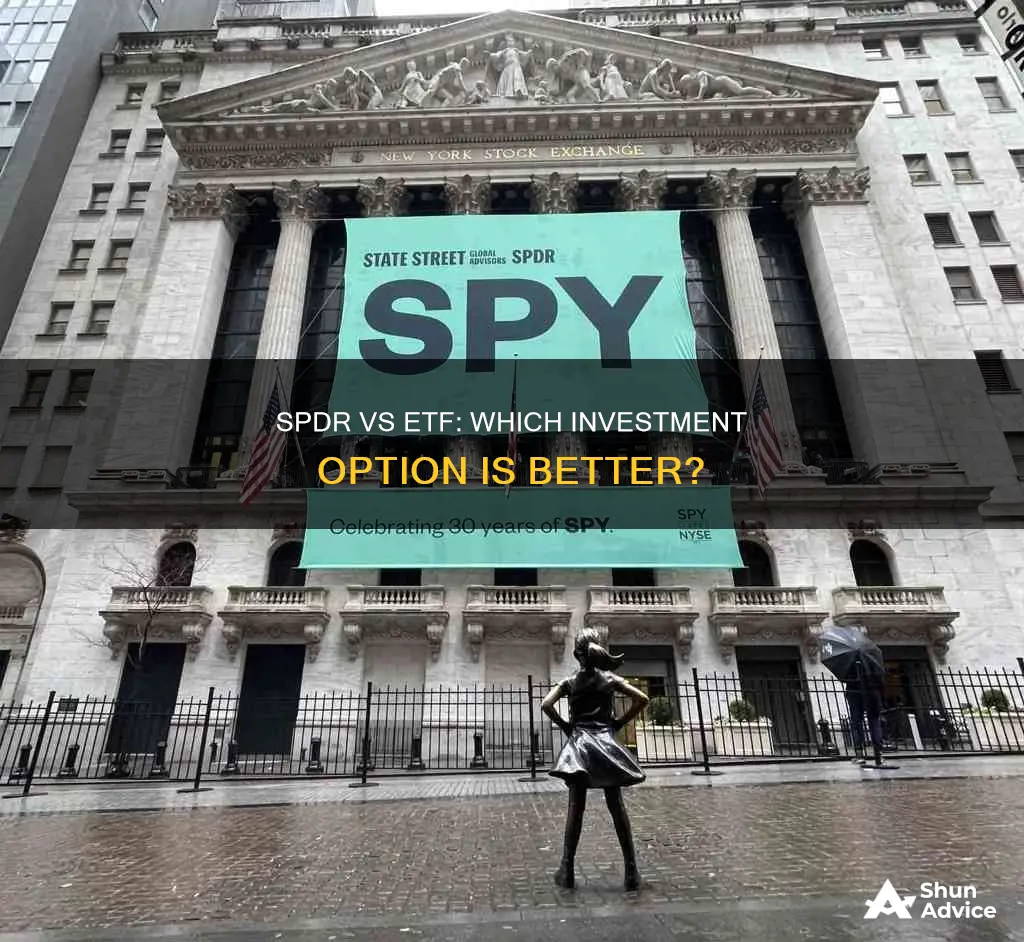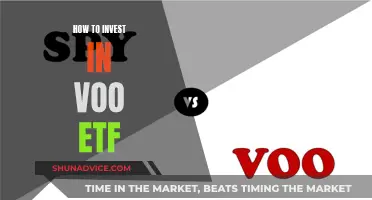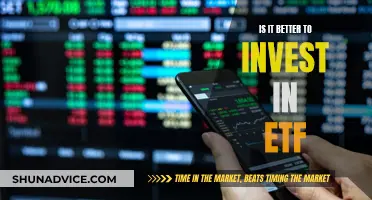
SPDRs, or Standard & Poor's Depositary Receipts, are a type of exchange-traded fund (ETF) that first began trading on the American Stock Exchange in 1993. SPDRs are issued by State Street Global Advisors and are designed to track indexes or benchmarks.
SPDRs have a fixed number of shares that are bought and sold on the open market and trade on exchanges like stocks. They are often chosen by investors because they offer low fees and broad diversification.
SPDRs can be a good investment for those who are new to investing, are investing for retirement, or don't want to research individual stocks. However, if you are investing money that you may need in the short term, or already own S&P 500 funds, it may be best to avoid SPDRs.
Some popular SPDRs include the SPDR S&P 500 ETF Trust, the SPDR Dow Jones Global Real Estate ETF, and the SPDR Portfolio Developed World ex-US ETF.
What You'll Learn

SPDR S&P 500 ETF: pros, cons, and alternatives
The SPDR S&P 500 ETF Trust (SPY) is an exchange-traded fund (ETF) that tracks the performance of the S&P 500 Index. Launched in 1993, it was the first ETF listed in the United States. SPY is one of the most well-known and popular ETFs, with net assets of over $568.7 billion.
Pros:
- Broad diversification: SPY provides exposure to a diverse range of companies across all eleven Global Industry Classification Standard (GICS) sectors, reducing the risk of concentrating your investments in a specific sector.
- Low cost: With an expense ratio of 0.095%, SPY is a low-cost option for investors. This is significantly lower than the average mutual fund fee of 0.55%.
- Liquidity: SPY is highly liquid, with nearly $18 billion in shares traded daily, making it easy for investors to buy and sell.
- Dividends: SPY collects dividends from all the dividend-paying stocks in the S&P 500 and passes them on to investors, providing a steady income stream. The dividend yield is currently around 1.6%.
- Historical performance: The S&P 500 has returned an average of 9.9% annually since 1928, including dividends, making it a solid long-term investment.
Cons:
- Overweighting large companies: SPY weights stocks based on their market value, which means it is dominated by the largest companies. The top 15 stocks account for about a third of its value.
- Impact of underperforming stocks: Since SPY owns all the stocks in the S&P 500, it is affected by the performance of individual companies. If a large company with a high weighting in the index underperforms, it can have a significant impact on the ETF's overall performance.
- Limited impact of outperforming stocks: On the other hand, if a stock with a low weighting in the index performs extremely well, it may not significantly boost the ETF's performance.
Alternatives:
- SPDR Portfolio S&P 500 ETF (SPLG): Tracks the S&P 500 and has a very low expense ratio of 0.02%.
- Vanguard S&P 500 ETF (VOO): Charges an expense ratio of 0.03%.
- IShares Core S&P 500 ETF (IVV): Also charges 0.03%.
- Schwab U.S. Large-Cap ETF: Another low-cost alternative.
Invest in Vietnam: A Guide to Vietnam-Focused ETFs
You may want to see also

SPDR vs ETF fees and liquidity
When comparing SPDR and ETF fees, it's important to note that SPDRs are a specific type of ETF (exchange-traded fund) issued by State Street Global Advisors. ETFs are a basket of securities that track a particular set of stocks within an index, and they trade like ordinary shares of stock. SPDRs are known for their low fees, with the SPDR Portfolio S&P 500 ETF Trust (SPLG) charging an expense ratio of 0.02%, which is significantly lower than its competitors. The SPDR S&P 500 ETF Trust (SPY) has an expense ratio of 0.0945%, which is still relatively low compared to other investment options.
On the other hand, ETFs that track the S&P 500 Index, like the Vanguard S&P 500 ETF (VOO), offer even lower expense ratios of 0.03%. It's important to remember that these fees do not include broker fees or commissions, which can add up, especially with frequent trading.
In terms of liquidity, SPDR ETFs offer excellent liquidity, which is vital in volatile markets. Investors want to be able to buy and sell securities quickly, easily, and at an attractive cost. SPDR ETFs represented 36.3% of the ETF industry's annual trading volume ($38 trillion) in 2023, making them the secondary market leader. The SPDR S&P 500 ETF Trust (SPY) is considered the largest exchange-traded fund by assets under management and is one of the most actively traded ETFs by daily volume.
The high liquidity of SPDR ETFs, particularly the SPY, makes them attractive to investors who value the ability to quickly buy or sell securities without significantly impacting the price of the security. This liquidity also appeals to traders who require deep liquidity for their strategies.
In summary, while SPDRs are known for their low fees, there are even lower-cost options available among ETFs, especially when considering the additional broker fees and commissions. However, SPDRs, specifically the SPY, stand out for their exceptional liquidity, making them a popular choice for investors and traders alike.
XBI SPDR S&P Biotech ETF: Unity Biotechnology Investment Analysis
You may want to see also

SPDR's performance and historical returns
SPDRs have been offering investors a diverse range of investment options since the first exchange-traded fund (ETF), the SPDR S&P 500 fund (SPY), was launched in 1993.
The performance and historical returns of SPDRs vary depending on the fund. Here is a look at the performance and historical returns of some of the SPDR ETFs:
SPDR Portfolio S&P 500 ETF Trust (SPLG)
The SPLG has offered investors exposure to the favourable long-term growth prospects of the entire U.S. stock market. While there is no historical data on the SPLG, the S&P 500 has rewarded investors with an average annualised return of approximately 10% over the past 100 years. The SPLG is a great option for investors seeking exposure to the total equity market as it reinvests dividends and employs various derivative strategies to generate additional income.
SPDR Dow Jones REIT ETF (RWR)
The RWR offers investors exposure to the real estate market and the opportunity to earn dependable cash flows. While there is no historical data on the RWR, REITs have historically been a solid choice during periods of rising inflation and interest rates as they are required to pay out at least 90% of their taxable income to shareholders.
SPDR SSGA US Sector Rotation ETF (XLSR)
The XLSR is the newest SPDR fund, launched in April 2019, and the only actively managed ETF on the list. While the fund has lagged behind the S&P 500 over the past 12 months, it has shown less volatility than its peer group on average over the past three and five years.
SPDR S&P Kensho New Economies Composite ETF (KOMP)
The KOMP has averaged an annual return of 97% since its inception in October 2018. The fund has a growth potential spiced by an OK dividend yield, making it a great choice for long-term investors who are comfortable with more investment volatility.
SPDR S&P 500 Fossil Fuel Reserves Free ETF (SPYX)
There is no historical data on the SPYX, but it strives to provide returns commensurate with the S&P 500 Fossil Fuel Free Index, which tracks the performance of S&P 500 component stocks except for companies that own fossil fuel reserves.
SPDR Portfolio Short Term Treasury ETF (SPTS)
The SPTS has a 10-year average annual return. While the 12-month yield may seem low compared to a typical high-yield bond ETF, the fund's focus on short-term Treasury bonds has made it a relative safe haven amid rising interest rates.
SPDR Portfolio Developed World Ex-U.S. ETF (SPDW)
The SPDW has a 10-year average annual return. The fund provides exposure to 24 international markets and broad diversification that curtails country-specific risk.
Financial Select Sector SPDR ETF (XLF)
The XLF has offered stellar returns to shareholders over the long haul. In the past 10 years, the fund has accumulated a total return of 129.6%.
SPDR S&P 1500 Value Tilt ETF (VLU)
There is no historical data on the VLU, but it offers investors a diversified portfolio of stocks with a value tilt.
SPDR Dow Jones Global Real Estate ETF (RWO)
The RWO was launched in May 2008 and has seen a cycle or two. While there is no historical data on the RWO, the fund has stabilised in recent years and is up about 30% from its October lows.
SPDR S&P 500 ETF Trust (SPY)
The SPY has offered the following returns over the past few years:
- 9.60% YTD Daily Total Return
- 28.76% 1-Year Daily Total Return
- 9.68% 3-Year Daily Total Return
A Beginner's Guide to S&P 500 ETF Investing
You may want to see also

How to buy SPDR: a step-by-step guide
SPDRs, or Standard & Poor's Depositary Receipts, are a type of exchange-traded fund (ETF) that can be bought and sold like shares of stock. Here is a step-by-step guide on how to invest in SPDRs:
- Fund your account: If you don't already have an investment account, you'll need to set one up. This can be a taxable brokerage account or a tax-sheltered retirement account. Once you have your account, transfer cash into it so that you're ready to buy SPDR shares.
- Search for the SPDR: Go to the trading dashboard of your investment account and enter the symbol or name of the SPDR you want to buy. You can find the list of symbols for different SPDRs on your broker's platform.
- Choose how many shares to buy: Decide how many shares you want to purchase. Your broker may show you the maximum number of shares you can buy based on the money you have in your account.
- Choose an order type: In most cases, you'll use a market order to purchase shares, which means your buy request goes through at the current price of the SPDR.
- Place the order: Once you have made your selections, place the order to purchase the SPDR shares. Congratulations! You are now an owner of SPDRs.
Remember to do your research before investing and consider seeking advice from a qualified financial advisor.
Myanmar ETF: A Guide to Investing in the Country's Future
You may want to see also

SPDR's top holdings and investment sectors
SPDRs are a type of exchange-traded fund (ETF) that began trading on the American Stock Exchange (AMEX) in 1993. Today, there are about 200 SPDR ETFs available to investors, with a broad range of options to build a core portfolio.
SPDR Portfolio S&P 500 ETF Trust (SPLG)
This SPDR ETF aims to provide exposure to the entire U.S. stock market and its long-term growth prospects. The fund reinvests dividends and employs derivative strategies to generate additional income. With an expense ratio of 0.02%, it is a cost-effective option for long-term investors.
SPDR Dow Jones REIT ETF (RWR)
The SPDR Dow Jones REIT ETF provides exposure to the real estate market through real estate investment trusts (REITs). REITs must pay out at least 90% of their taxable income to shareholders, making them a dependable source of cash flow. This SPDR ETF focuses on the industrial, residential, retail, healthcare, and self-storage sectors.
SPDR SSGA US Sector Rotation ETF (XLSR)
The SPDR SSGA US Sector Rotation ETF is an actively managed fund that aims to identify and invest in sectors poised to outperform the overall market. Its top sectors include technology, consumer cyclicals, healthcare, industrials, financials, and communications.
SPDR S&P Kensho New Economies Composite ETF (KOMP)
This SPDR ETF focuses on companies driving innovation across various sectors, including technology, industrials, and healthcare. It seeks to capture the returns of companies involved in areas like artificial intelligence, robotics, and automation.
SPDR S&P 500 Fossil Fuel Reserves Free ETF (SPYX)
The SPDR S&P 500 Fossil Fuel Reserves Free ETF is a sustainable investing option that excludes companies owning fossil fuel reserves. It strives to provide returns similar to the S&P 500 Fossil Fuel Free Index and holds stocks of mega-cap companies like Apple, Microsoft, Amazon, and Tesla.
SPDR Portfolio Short Term Treasury ETF (SPTS)
The SPDR Portfolio Short Term Treasury ETF is a bond ETF that focuses on short-term U.S. Treasury bills and notes with maturities between one and three years. It offers a relatively safe investment option, especially in a rising interest rate environment.
SPDR Portfolio Developed World Ex-U.S. ETF (SPDW)
The SPDR Portfolio Developed World Ex-U.S. ETF provides exposure to international stocks from 24 markets. It offers diversification by country, sector, and company, helping investors avoid "home-country bias." The ETF has an ultra-low-cost expense ratio and provides exposure to large-, mid-, and small-capitalization firms.
Financial Select Sector SPDR ETF (XLF)
The Financial Select Sector SPDR ETF is one of the sector funds that tracks the performance of financial stocks within the S&P 500 Index. Its top holdings include Warren Buffett's holding company, Berkshire Hathaway, and it has a strong long-term performance track record.
SPDR S&P 1500 Value Tilt ETF (VLU)
The SPDR S&P 1500 Value Tilt ETF provides exposure to value stocks, which tend to have solid balance sheets and provide steady cash flow to shareholders. It tracks the performance of the S&P 1500 Low Valuation Tilt Index and has a five-star rating from Morningstar.
SPDR Dow Jones Global Real Estate ETF (RWO)
The SPDR Dow Jones Global Real Estate ETF invests in real estate investment trusts (REITs) and real estate operating companies globally, with a focus on the U.S., Japan, and the U.K. It provides exposure to various real estate sectors, including retail, industrial, and residential.
These SPDR ETFs offer diverse investment options, allowing investors to build solid portfolios suited to their goals and strategies.
ETFs: A Guide to Getting Started with Investing
You may want to see also
Frequently asked questions
SPDR stands for Standard & Poor's Depositary Receipts. It is a type of exchange-traded fund (ETF) that trades on the American Stock Exchange (AMEX).
Shares of SPDR funds are bought and sold on the open market and trade on exchanges like stocks. On the other hand, mutual fund shares are created and redeemed by a mutual fund company.
SPDR ETFs offer broad exposure to the large-cap blend segment of the US equity market. They are passively managed, have low fees, and provide diversified exposure, minimising single-stock risk.
You can invest in SPDR ETFs by opening and funding a brokerage account. Then, enter the ticker symbol of the desired SPDR ETF, indicate the number of shares or the dollar amount you want to invest, and place a market or limit order.
Some popular SPDR ETFs include the SPDR S&P 500 ETF (SPY), SPDR Dow Jones Global Real Estate ETF (RWO), and SPDR Portfolio Developed World ex-US ETF (SPDW).







